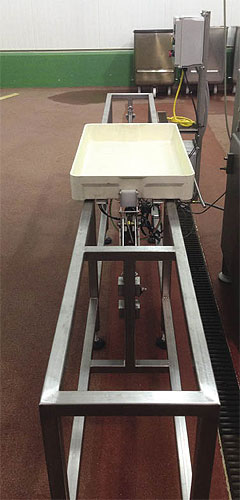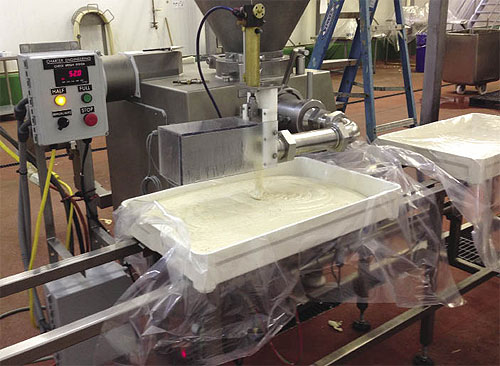Components Automate Manual Fill Operation
 |
Original Article, February 2014 |
 Charter Engineering Group was contracted by a Northwest US-based food manufacturer to design and fabricate a machine to automate a manual fill operation. The fill material is a heated, viscous cheese product that is poured into fiberglass trays and later cooled and cut for packaging. Clippard Instrument Laboratory supplied the pneumatic components used in the design. "Clippard components have been used by our company on many projects over many years. The cylinders are long-life products offering stainless-steel washdown and reliability of use," said Jay Rosen, professional engineer and owner of Charter Engineering Group. "The costs are equivalent to other vendors. More importantly, the sales applications staff has always been helpful and supportive on product questions for new and custom applications." The machine, marketed as "Index and Fill", continuously measures the weight of food product emptying into the trays and includes a forward push system. The index push system is fully pneumatic and uses two, 2-in. bore air cylinders (model UDR-32) with magnetic pistons, external cylinder mounted reed switches (RPS-S3), and meter out flow control valves (model JFC) to control the indexing motions. "Competitive quotations suggesting electrical designs that incorporated stepper motors and encoders, PLC programming and similar designs were eliminated by the customer as too costly and complicated and not easily maintained by plant personnel," said Rosen. "Similarly, designs using conveyor belts were discussed as being difficult to clean." 
In this application, the trays are filled with product to a customer-selected weight (typically 40 to 100 lb) while air cylinders and pneumatic logic control the index movements.
In operation, the trays are weighed on custom designed load cell rails. Weight actuates the pneumatic index system, moving the trays in a 3-step direction with air cylinders. The front tray length is filled to one-half the finish weight and then indexed forward and filled to the final weight. The trays are then pushed forward to the unload position. What was a three-to-four person manual push and weigh operation has been simplified to a one-man operation. These machine steps are being repeated for several hundred trays in a production day. Similar applications exist to fill and move bags, boxes, crates, and large containers with food product of higher fill weights (typically 25-plus lb) and container throughput of 15 sec. and greater. The machine is design-built to meet USDA and FDA food sanitation standards. The frame construction is stainless steel and all components are NEMA 4X. |





